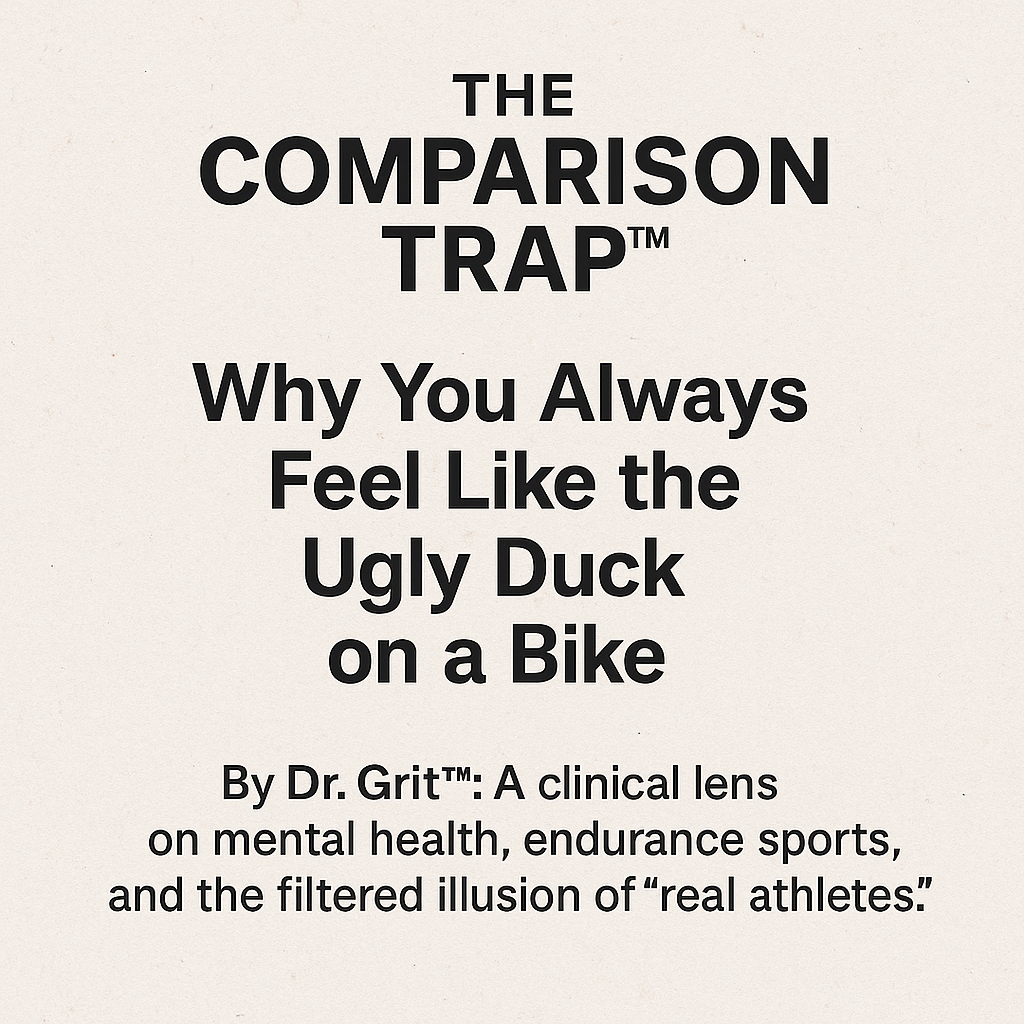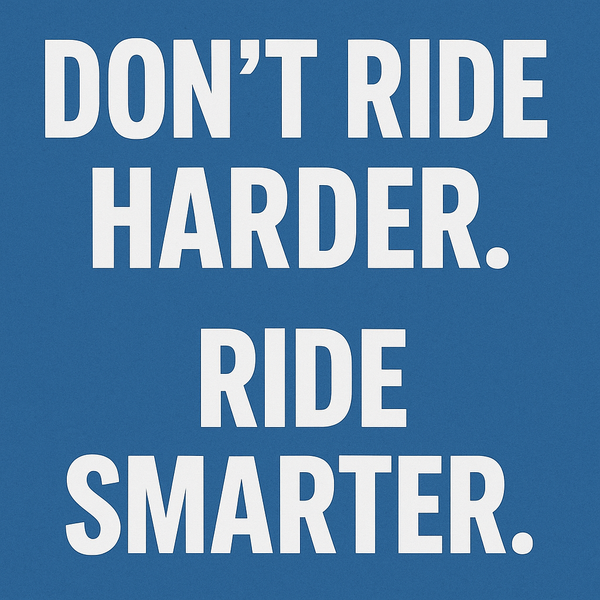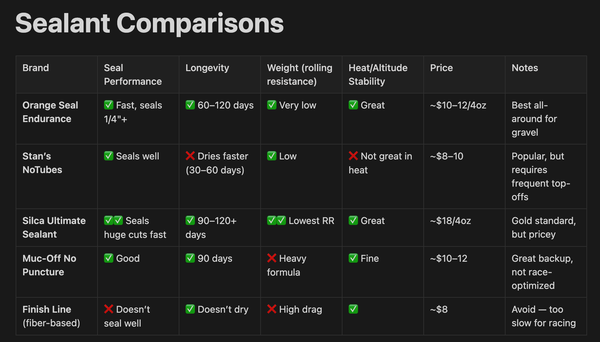The Comparison Trap™: Why You Always Feel Like the Ugly Duck on a Bike

By Dr. Grit™: A clinical lens on mental health, endurance sports, and the filtered illusion of “real athletes.”
The Story: Megan and the Myth of the “Real Athlete”
It's 5:11 a.m. Megan—mom of two, Zoom warrior, and cereal-dinner connoisseur—stands in the kitchen with a trembling cup of coffee. The house is still quiet, kids sleeping like little angels with sticky fingers. But she’s already exhausted just from looking at her calendar: soccer pickup, staff check-ins, that one meeting that absolutely could’ve been an email.
And somewhere in that chaos, she's training for her first long-distance gravel race.
Her training plan exists only as a coffee-stained napkin on the fridge. Her bike shorts—vintage but not in a cool way—have seen better decades. Yet somehow, between diaper changes, client calls, and hill repeats that feel straight-up punitive, she’s making it work.
Then, like every modern athlete, she opens Instagram.
There it is again. Another radiant group ride photo—sun-kissed quads, $400 kits, not a puffy under-eye in sight. Perfectly filtered smiles framed by perfectly timed golden hour. She squints, scrolls, scoffs: “The only filter I use is caffeine.” Still, a voice whispers somewhere deep: Do real athletes ever look like… me?
Welcome to the Comparison Trap™.
The Psychological Fallout of Comparison Culture
Mirror Exposure & Self-Discrepancy Theory: Your Brain on Social Media
What Megan and countless amateur athletes experience isn’t vanity—it’s psychology. Repeated exposure to idealized, filtered athletic content triggers mirror exposure theory and, more profoundly, self-discrepancy theory (Higgins, 1987).
Self-discrepancy theory posits that emotional distress occurs when there’s a dissonance between one’s actual self and their “ideal” or “ought” self (Higgins, 1987). For endurance athletes flooded with curated highlight reels, that ideal self becomes a mash-up of elite cyclists, sponsored runners, and influencers genetically blessed with Instagrammable hydration habits.
The message is clear: You do not look like them. You must not belong here.
Social media amplifies this distortion. Research confirms that frequent upward social comparisons increase body dissatisfaction and negatively impact motivation (Fardouly et al., 2015; Myers & Crowther, 2009). Athletes who scroll group ride selfies are comparing their sweaty selfies to someone else's highly edited finish-line flex.
Body Schema Distortion: The Paradox of Training
What’s more confusing? You train more and feel worse about your body. That’s body schema distortion in action: a warped internal representation of physical form that remains negative even as physiological performance improves (Leit et al., 2002).
In endurance sports, where social media is saturated with lean, sinewy images, the cognitive bias intensifies. Even improving athletes may still not “see” improvement because the visual reference point keeps shifting.
These athletes are actually embodying strength and endurance—but because they don't look like a filtered archetype, they don't feel like athletes.
Social Comparison Fatigue: A Real Emotional Burnout
Chronic engagement with curated content leads to what psychologists call social comparison fatigue—constant mental strain from measuring oneself against perceived perfection (Tiggemann & Slater, 2014). Studies show this results in:
- 📉 Decreased motivation and confidence
- 📈 Increased self-doubt and appearance-related anxiety
- 📦 A shopping habit aimed at fixing perceived flaws (“If I get the same bike/socks/kits, I’ll feel legit.”)
This is more than just insecurity. It’s the neural result of a constant dopamine-deficit cycle where no amount of training, effort, or sweat earns the reward of self-worth.
Clinical Recommendations for Athletes
It’s possible to escape the Comparison Trap™, but it requires intentional effort rooted in clinical best practices.
Mindset Work for the Individual
- Practice Self-Compassion
Instead of defaulting to shame, adopt a kinder internal dialogue. Studies show that self-compassion not only reduces body dissatisfaction but improves resilience during setbacks (Neff & Germer, 2013; Mosewich et al., 2013). - Curate Your Feed
Consciously follow creators and athletes who share raw, real, and diverse bodies in sport. Hide or unfollow content that consistently triggers comparison. - Mindful Exposure
If social media sparks anxiety post-scroll, limit time exposure or schedule time away (Fardouly et al., 2015). - Mantra Therapy
Place this sticky note on your mirror: “I am a real athlete. My body is the receipt.” - Document the Mess
Take sweaty selfies, gut-shot bike pics, and gravel rash photos. Documenting and sharing true training moments acts as a personal and collective form of clinical exposure therapy (Levinson et al., 2018).
How Fellow Athletes and Coaches Can Help
Creating change also requires community-level support. Here’s how to support athletes in your orbit:
- Celebrate the Grit, Not Just the PRs
Acknowledge training consistency, mental breakthroughs, finishing tough rides—not just podiums or metrics. - Include Everyone—Visibly
Post group photos that feature diversity in size, pace, age, gender, and facial expressions (yes, mid-ride grimaces included). - Reach Out After Races
If someone hasn’t posted or appears withdrawn, check in. It could be insecurity, not disinterest, keeping them distant. - Create Mentorship Moments
Lead athletes should talk openly about struggles—burnout, injury, imposter syndrome. Vulnerability from leaders creates safety for everyone else. - Build Buddy Systems
Pair up for long rides or accountability check-ins. Social support boosts motivation and reduces feelings of isolation (Neff & Germer, 2013).
Final Thoughts From Dr. Grit™
Comparison isn’t just the thief of joy—it’s the thief of athletic identity. But we have the power to take it back.
Unfiltered bodies. Sweaty smiles. Glitchy GPS files. That’s what real athletes are made of.
So the next time you feel like the ugly duck on a bike, remember: “If your ride photo doesn’t look like a crime scene, did you even push hard enough?”
Flex less. Post the messy stuff. And show someone else they belong too.
References
Fardouly, J., Diedrichs, P. C., Vartanian, L. R., & Halliwell, E. (2015). Social comparisons on social media: The impact of Facebook on young women's body image concerns and mood. Body Image, 13, 38–45. https://doi.org/10.1016/j.bodyim.2014.12.002
Higgins, E. T. (1987). Self-discrepancy: A theory relating self and affect. Psychological Review, 94(3), 319–340. https://doi.org/10.1037/0033-295X.94.3.319
Leit, R. A., Gray, J. J., & Pope Jr., H. G. (2002). The media's representation of the ideal male body: A cause for muscle dysmorphia? International Journal of Eating Disorders, 31(3), 334–338. https://doi.org/10.1002/eat.10019
Levinson, C. A., Fewell, L., Brosof, L. C., & Stark, L. (2018). Exposure therapy for body image disturbance: A randomized controlled trial. Body Image, 25, 89–98. https://doi.org/10.1016/j.bodyim.2018.02.005
Mosewich, A. D., Crocker, P. R. E., Kowalski, K. C., & DeLongis, A. (2013). Applying self-compassion in sport: An intervention with women athletes. Journal of Sport & Exercise Psychology, 35(5), 514–524. https://doi.org/10.1123/jsep.35.5.514
Myers, T. A., & Crowther, J. H. (2009). Social comparison as a predictor of body dissatisfaction: A meta-analytic review. Journal of Abnormal Psychology, 118(4), 683–698. https://doi.org/10.1037/a0016763
Neff, K. D., & Germer, C. K. (2013). A pilot study and randomized controlled trial of the mindful self-compassion program. Journal of Clinical Psychology, 69(1), 28–44. https://doi.org/10.1002/jclp.21923
Tiggemann, M., & Slater, A. (2014). NetGirls: The Internet, Facebook, and body image concern in adolescent girls. International Journal of Eating Disorders, 47(6), 630–643. https://doi.org/10.1002/eat.22254
Disclaimer: This content is for educational and informational purposes only and is not intended to diagnose, treat, or provide medical or psychological advice. Always consult a licensed medical or mental health professional for guidance specific to your situation. Amanda Duling is not a licensed clinician or psychologist. All participation in training, mental reframing, or athletic activities is voluntary and at your own risk.
© 2025 One Gear Short of Normal™. All rights reserved.
The Comparison Trap™, Dr. Grit™, and “If your ride photo doesn’t look like a crime scene, did you even push hard enough?”™ are trademarks of Amanda Duling and One Gear Short of Normal™. Unauthorized use is prohibited.



